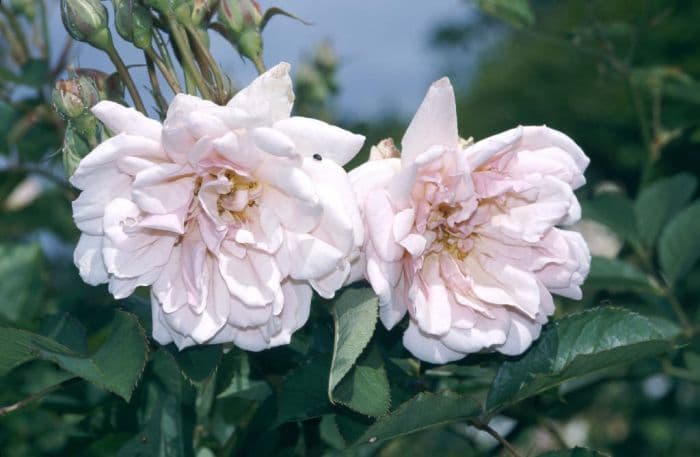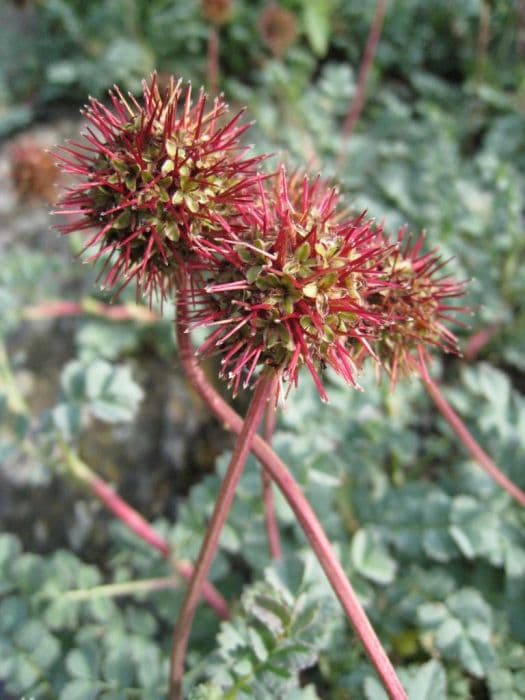Felicia Rose Rosa 'Felicia' (HM)

ABOUT
The Rosa 'Felicia' is a delightful rose bush that showcases beautiful, ruffled flowers. These charming blooms are often soft pink, with the petals blending to a paler hue as they approach the edges. The flowers are full and densely packed with petals, giving them an opulent and classic rose appearance. Each bloom possesses a sweet, musky fragrance that is quintessentially characteristic of rose scents, a trait that adds to the sensory appeal of the plant. The foliage of 'Felicia' is lush and typically glossy, presenting a fresh, deep green color that contrasts elegantly with the light pink blooms. The leaves may also show serrated edges, which is common in rose bushes. This plant presents a graceful silhouette throughout its blooming season, with the flowers clustering toward the tips of the branches. The blooms may be observed in generous clusters, contributing to a profuse and extended display of color that can uplift any garden setting. While it is important to appreciate the aesthetics, it is equally essential to recognize the utility of roses like 'Felicia' in the garden. They serve as excellent choices for borders, beds, and even as specimen plants. With proper care, including regular watering and pruning, 'Felicia' will continue to be a source of visual delight with its recurring blooms, often from late spring to early fall, depending on the local climate.
About this plant
 Names
NamesFamily
Rosaceae
Synonyms
Felicia Rose, Hybrid Musk Rose
Common names
Rosa 'Felicia' (HM)
 Toxicity
ToxicityTo humans
The plant commonly known as Rose is not considered toxic to humans. Roses do not contain substances that typically pose a risk of poisoning when touched or ingested in small quantities. However, care should be taken as the thorns on rose bushes can cause physical injury if handled improperly. Ingesting large quantities of any plant material can potentially lead to gastrointestinal discomfort, but roses are not known for being harmful when eaten in moderation.
To pets
The Rose is generally recognized as non-toxic to pets, including cats and dogs. It does not contain substances that are known to be poisonous to animals. While the ingestion of rose petals in small amounts is unlikely to cause harm, consumption of large quantities of plant material may lead to mild gastrointestinal upset for pets. As with humans, caution should be exercised to prevent injury from the thorns of rose bushes.
 Characteristics
CharacteristicsLife cycle
Perennials
Foliage type
Deciduous
Color of leaves
Green
Flower color
Pink
Height
4 feet (1.22 meters)
Spread
4 feet (1.22 meters)
Plant type
Shrub
Hardiness zones
6
Native area
Cultivar
Benefits
 General Benefits
General Benefits- Ornamental Appeal: Rosa 'Felicia' adds aesthetic value to gardens with its beautiful pink blooms and abundant flowering.
- Fragrance: The plant is known for its pleasant and sweet aroma, which can enhance the sensory experience of a garden.
- Pollinator Attraction: This variety of rose is attractive to bees and other pollinators, thereby supporting biodiversity.
- Ease of Growth: Rosa 'Felicia' is considered easy to cultivate, making it accessible for gardeners of all skill levels.
- Drought Tolerance: Once established, the plant is relatively drought-tolerant, requiring less frequent watering than some other garden plants.
- Long Blooming Period: It typically has a long flowering season, providing color and interest over an extended period.
- Versatility: This rose can be used in various garden designs, including borders, hedges, and as a standalone specimen.
 Medical Properties
Medical PropertiesThis plant is not used for medical purposes.
 Air-purifying Qualities
Air-purifying QualitiesThis plant is not specifically known for air purifying qualities.
 Other Uses
Other Uses- Culinary decoration: Petals of Rosa 'Felicia' can be used to add a touch of elegance when decorating cakes or desserts.
- Natural dye: The petals can be used to create natural dyes for fabrics or art projects, with varying hues achieved through different processing techniques.
- Floral water: Petals can be steeped in water to create a fragrant floral water for use in homemade cosmetics or as a room spray.
- Aromatherapy: The scent of Rosa 'Felicia' can be captured in essential oils and used in aromatherapy practices for its soothing properties.
- Bath additive: Dried petals can be added to bathwater for a luxurious and aromatic bathing experience.
- Companion planting: Rosa 'Felicia' can be an effective companion plant in gardens, attracting pollinators and beneficial insects to the area.
- Handmade paper: Incorporating Rosa 'Felicia' petals into handmade paper can add texture and visual interest.
- Potpourri: Dried petals can be mixed with other aromatic herbs to create potpourri for naturally scenting a room.
- Rose petal jam: Although not used for its medicinal value, Rosa 'Felicia' petals can be used to make a unique and flavorful rose petal jam.
- Perfumery: The fragrance of Rosa 'Felicia' can inspire or be replicated in perfumes and body mists.
Interesting Facts
 Feng Shui
Feng ShuiThe rose is often used in Feng Shui to attract love energy, enhance relationships, and promote a sense of peace and happiness. Pink roses like 'Felicia' can be placed in the southwest sector of a garden or room to strengthen love and marriage prospects. They can also be used to soften the energy in a space, promoting a calming atmosphere.
 Zodiac Sign Compitability
Zodiac Sign CompitabilityThe rose is not used in astrology practice.
 Plant Symbolism
Plant Symbolism- Love: As a rose, 'Felicia' is predominantly associated with the emotion of love, embodying both romantic love and affection.
- Beauty: The rose universally symbolizes beauty, and the 'Felicia' variety, with its attractive blossoms, echos this sentiment.
- Mystery: Roses sometimes symbolize mystery or secrecy, and the 'Felicia' rose, with its delicate folds and unique shades, can represent the complexity and depth of something that is yet to be fully revealed.
- Balance: The symmetrically-formed petals of 'Felicia' roses suggest balance and harmony, reflecting the equilibrium found in nature and relationships.
- Honor: Giving a 'Felicia' rose to someone can be a sign of honor, signifying respect and admiration for the person receiving it.
- Devotion: Roses are also a symbol of devotion and fidelity, an indication of committed love and loyalty, values which the 'Felicia' rose upholds through its enduring blooms.
 Water
WaterThe Felicia rose should be watered deeply once or twice a week, depending on the weather, to encourage deep root growth. Provide about 1 to 2 gallons of water for mature plants, less for younger ones. During hot and dry periods, increase the frequency of watering without letting the soil become waterlogged. In cooler weather or rainy periods, reduce the amount. Ideally, water early in the day to allow leaves time to dry and prevent fungal diseases.
 Light
LightFelicia roses thrive in full sunlight, needing at least 6 hours of direct sunlight a day for optimal growth and blooming. Plant them in a spot that receives morning sun and light afternoon shade in regions with very hot summers to prevent stress.
 Temperature
TemperatureFelicia roses are hardy in USDA zones 5 through 10, tolerating temperatures down to about -20°F once established. Ideal growing temperatures are between 70°F and 80°F during the day. They can handle temperature swings, but extreme heat over 90°F can stress the plant and impede blooming.
 Pruning
PruningPrune Felicia roses in late winter or early spring to shape the plant, remove dead or diseased wood, and encourage vigorous new growth. Deadhead spent flowers during the blooming season to promote continuous blooms. The best time for major pruning is when the plant is dormant.
 Cleaning
CleaningAs needed
 Soil
SoilFelicia roses thrive in loamy, well-draining soil with a pH between 6.0 and 7.0. A mix of two parts loam to one part peat moss and one part compost provides nutrients and proper drainage. Ensure the soil is enriched with organic matter to support healthy growth.
 Repotting
RepottingFelicia roses typically do not require frequent repotting as they are outdoor plants. Instead, replace the top layer of soil annually and provide fresh mulch to maintain nutrient levels. These roses may only need repotting if they outgrow their space or exhibit poor health.
 Humidity & Misting
Humidity & MistingFelicia roses prefer moderate humidity levels but are adaptable to various conditions. They do not require specific humidity control when planted outdoors, as natural air circulation generally provides the necessary humidity for healthy growth.
 Suitable locations
Suitable locationsIndoor
Ensure bright, direct light and good air circulation for indoors.
Outdoor
Plant in full sun, provide ample water, and protect from harsh winds.
Hardiness zone
6-9 USDA
 Life cycle
Life cycleThe life of 'Felicia' rose (Hybrid Musk) begins with seed germination, where the seed requires a period of stratification to break dormancy. Once sprouted, the seedling grows and develops into a young plant with a strong root system and shoots. As the rose matures, it enters a vegetative stage where foliage expands and stems elongate. This is followed by the flowering stage when buds form and eventually bloom into clusters of fragrant pink flowers typically in late spring to early summer with recurrent blooming throughout the growing season. After pollination, if it occurs, the rose produces hips (fruit) containing seeds for the next generation, although this rose variety is often propagated by cuttings for genetic consistency. As temperatures drop in autumn, the plant goes into dormancy, reducing its metabolic activities to survive the winter before the cycle begins anew in spring.
 Propogation
PropogationPropogation time
Spring-Early Summer
The Rosa 'Felicia' (Hybrid Musk Rose) is commonly propagated through a method known as softwood cuttings. This process is best undertaken in late spring or early summer when the plant's new growth is still flexible and not yet mature. The gardener selects a healthy stem with recent growth, cuts a section approximately 4 to 6 inches (10 to 15 centimeters) long just below a node, and removes the lower leaves to reveal a clear stem. This cutting is then dipped in a rooting hormone to encourage root development and planted in a well-draining soil mixture. It's essential to maintain consistent moisture and a humid environment around the cutting, often achieved by covering the pot with a plastic bag or dome until the cutting has rooted. This can take several weeks, after which the new plant can eventually be transplanted to a more permanent location in the garden.









